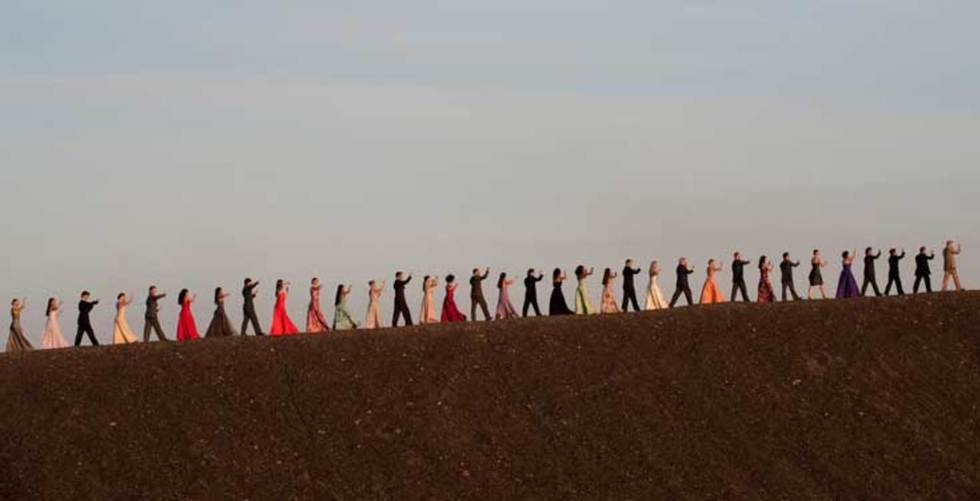
BY JACOB WILSON |
Tribeca Flashpoint: Wim Wenders on Pina
The iconic German filmmaker discusses his latest documentary Pina, 3D movie-making, and modern German cinema.


Ensemble of Pina/Credit: Donata Wenders
Jacob Wilson, a student at Tribeca Flashpoint Media Arts Academy, recently sat down with renowned writer/director Wim Wenders to discuss his new film, Pina. Thanks to a dual partnership with IFC Films and the Chicago International Film Festival, Wilson produced and edited an interview with the German experimental fillmmaker where they cracked jokes, discussed Pina, and covered how Wenders would like "to change the minds of people who think dance is not for them."
As I was handed my 3D glasses for the screening of Wim Wenders’ new film Pina, I noticed that the theater was practically empty. The Chicago International Film Festival put on this screening just for press, so the lack of fellow patrons should be unsurprising. I was nonetheless left to ponder the circumstance. Any other movie made in 3D would probably pack the house, given the mainstream appeal of recently released 3D action adventure, special effects rides. Pina, an art flick about interpretative dance directed by an experimental German filmmaker, may lack the crowd, but still comes wrapped in the same three-dimensional packaging.
Speaking as a fan and admirer of Wim Wenders’ work, I was left in awe by what I saw on the screen. The sense of depth created by 3D photography, the avant-garde documentary style of the director, and the dances themselves made me yearn for more exposure to these subjects. Lucky for me, I got the opportunity to receive just that when I was asked to participate in and film a roundtable discussion with director Wim Wenders himself. What would follow was for me not only educational but personal, as both filmmaker and film lover.

Dancers of Pina/ Credit: Donata Wenders
To begin, I was flabbergasted when asked to interview Mr. Wenders. My first experience with his work came when I was doing my undergraduate work at the University of Illinois at Chicago. I decided to use my remaining electives on film courses, despite my Political Science major. One of the first films we screened was Wim Wenders’ Alice in the Cities. The captivating cinematography, unconventional storytelling, and themes of wanderlust deeply affected me. I personally went on to view as much of Wim Wenders’ work as I could; other favorites included Buena Vista Social Club, Wings of Desire, Paris Texas, and Don’t Come Knocking.
That being said, Pina has definitely earned a place amongst my favorite works by Wenders, not to mention the fact that I now had an opportunity to discuss one of his pieces with the man himself. I figured that being part of a roundtable discussion would mean I’d get to ask one, maybe two questions at most. However, I later found out that the other participating colleges had to back out at the last minute. This meant I would have a whole fifteen minutes of just Wim (pronounced Vim) and me. Naturally, I was thrilled and also terrified, trying to cherry-pick which questions to ask about which subjects.
The result was nothing short of stupendous. I met Mr. Wenders at the Park Plaza Hotel on Michigan Avenue the third Wednesday in October. It was a cold afternoon, blustery yet sunny. Wim, as he preferred to be called, had just eaten a buffet lunch that made him very satisfied. I had not eaten, out of nervousness. My cameraman Rodolfo Rubio had set up the shot perfectly within a very short frame of time. However, because the equipment office could not spare us a boom mike on such short notice, we had to do with the on-camera microphone and a Garage Band recording on my laptop. The funny thing is, Wim is extremely soft-spoken. Thank goodness we recorded sound on multiple devices; it definitely saved our production.
Wim Wenders Interview (Subtitled) from Jacob Wilson on Vimeo.
Wim and I started our conversation on the subject of his new film Pina. He waxed nostalgically about how he had never been interested in dance, let alone interpretive dance, until he had seen the works of maestro Pina Bausch, the film’s subject. She began her work during the early 1970s, just as Wenders was beginning to establish himself as a new voice in German cinema. They both met with success for the first time in Wuppertal, Germany, the site of Pina’s dance theatre and a primary location in Wenders’ film Alice in the Cities. I mentioned to Wim how much it excited me to see him use moving camera shots of the city’s monorail, named the Wuppertal Schwebebahn, in both Alice in the Cities and Pina. He let me know that there’s really nothing else special about the little German town, except for Pina.
Her friendship with Wenders spawned out of the hope that one day they would work together. Wenders wanted to find a way to capture the beauty of movement in Pina’s dances. When 3D technology resurfaced in the early 2000s, Wenders believed he had found the perfect filmic medium. He hopes, in fact, to continue shooting in 3D, but remains wary about employing 3D conversion with any of his past movies. He likened this process to the colorization of black-and-white movies during the late eighties and early nineties. However, Wim did concede that if he could have made any of his films in 3D, it probably would have been Wings of Desire. This was due to the focus on movement in the frame that is also vastly important to the success of Pina in 3D.

Dancers of Pina/Credit: Donata Wenders
Unfortunately, Pina herself died just as pre-production began, delaying the film for two years. Her dancers, thus, became the primary players in the movie. Many times, in fact, they appear as talking heads that don’t talk but instead provide inner monologue about Pina and her/their work. Wenders described them as “silent heads” that blur the line between documentary and fiction.
Among other important topics of conversation, we discussed his opinion of modern German cinema. One filmmaker he’s very interested in is Andres Veiel, whose film If Not Us, Who? also played at the Chicago International Film Festival. Wenders himself has taken a prominent role as teacher of young German filmmakers, and he takes much pride in that. Preparing the next crop of filmmakers is very important to the cycle of cinema.
I couldn’t agree with him more—one of many reasons why I was so gratified to have the chance to interview him. Whether it's my love for movies or my love of making them, listening to and learning from a past and present master of the silver screen like Wim Wenders has both enhanced my knowledge and kicked me into another gear.
Pina is playing in selected theaters across the US. Click here to find tickets in a city near you.
 Check into Pina on Get Glue.
Check into Pina on Get Glue.
Watch the official trailer:
For more about Tribeca Flashpoint Media Arts Academy, including information on our two-year Associate Degree programs in Film & Broadcast, Recording Arts, Game & Interactive Media, or Animation & Visual Effects, please visit www.tribecaflashpoint.com.

